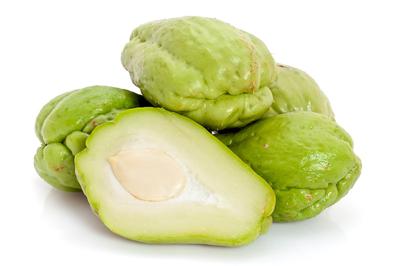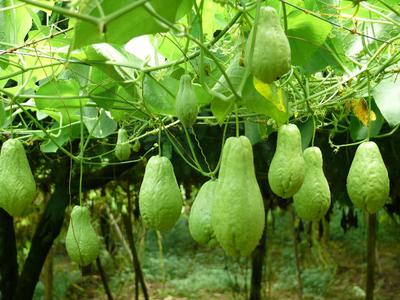VANILLA BEANS | SOYBEAN OIL | SOYMEAL & CAKE | COCOA BEANS | COFFEE BEANS
How to grow CHAYOTE in Uganda

Chayote Fruits in Uganda
Chayote (Scientific Name: Sechium edule) is an edible plant belonging to the gourd family Cucurbitaceae, along with melons, cucumbers and squash.
The vegetable is commonly known as ‘Ensusuti’ in Luganda.
Globally it is known by other names including christophine cho-cho, sayote (Philippines), pipinola (Hawaii), pear squash, vegetable pear, or choko (Australia and New Zealand).
Its tuberous and edible root is called chinchayote or chayotextle in Mexico and ichintal or güisquil in El Salvador, Guatemala and Venezuela.
In Brazil it is called chuchu.
This vinning plant produces delicious one seeded fruit that is mainly consumed for its dietary benefits.
The fruit has a flavor similar to squash and is used much like squash in recipes.
Common Chayote varieties in Uganda
There are mainly two commercial chayote varieties, and these include;
Pear shaped - these are medium sized chayote with smooth skin and a pale green exterior with a lighter green flesh.
Globular shaped - these are pale green, smooth skinned chayote with a lighter green flesh.
Contact us here to buy Chayote fruits and Chayote Seedlings in Uganda
Soil requirements for growing Chayote in Africa
To give a prolific production, the plant requires a well-drainned, sandy loam soils, with a pH ranging between 6.0-6.8.
How to propagate Chayote on your farm
You can propagate the plant from vegetative cuttings or use seeds, the seeds of the plant usually pre-germinate with in mature fruits.
Contact us here to buy Chayote fruits and Chayote Seedlings in Uganda
How to plant Chayote in Uganda
Chayote planting can be started using pre-germinated seeds or the whole chayote fruit.
Prepare hills/mounds on a well cleared field space. At a spacing of 2.5m to 3.5m apart in rows.
To plant, open up the fruit to release the seed to enable you keep the fruit for use, then place 2cm deep hole.
Alternatively you can set the whole chayote fruit at an angle with the shoot downward, and the narrow base protruding very slightly at the surface in a 4 or 6 inches deep.
Like most cucumber family plants provide support in form of a strong fence or trellis to enable the vine stems to ascend up for wide spreading.
To enhance soil fertility you can mix chicken manure with soil upon planting.
Alternate chayote with other crops like peppers, squash, maize, celery or even mint to double up your gains.
However, watch out for pests and diseases like aphids as these usually attack the vines.
Contact us here to buy Chayote fruits and Chayote Seedlings in Uganda
How best to Harvest Chayote in Africa
Chayote is ready for harvesting when the fruit is tender and about 4 to 6 inches in diameter.
This usually takes about 120 to 150 days from planting.
To harvest, cut the chayote fruit from the vine using a knife and do it before the flesh gets hard.
Dice the chayote fruit and mix with g.nuts to taste.
Contact us here to buy Chayote fruits and Chayote Seedlings in Uganda
About the Market and Uses of Chayote
Aside enjoying your chayote fruit at home, you can market your excess chayote fruits in Uganda farmer markets like Nakaseero, Owino, or even kasubi.
The chayote fruit is used in mostly cooked forms. When cooked, chayote is usually handled like summer squash, it is generally lightly cooked to retain the crispy consistency.
Though rare and often regarded as especially unpalatable and tough in texture, raw chayote may be added to salads or salsas, most often marinated with lemon or lime juice.
Whether raw or cooked, chayote is a good source of vitamin C.
Although most people are familiar only with the fruit as being edible, the root, stem, seeds and leaves are edible as well.
The tubers of the plant are eaten like potatoes and other root vegetables, while the shoots and leaves are often consumed in salads and stir fries, especially in Asia.
Contact us here to buy Chayote fruits and Chayote Seedlings in Uganda
Quick Tips for growing chayote fruits
- Open up land meant for planting to clear it of shrubs.
- Decide on the method to use for planting, it could be on hills or in rows.
- Drill up holes on a hill on in rows about 1-2 cm deep
- Sow 3 to 6 seeds per hole and maintain a spacing of 2.5m to 3.5m between the plants.
- Cover the sown seeds with soil and gently firm. Water the plant constantly as fruits grown in dry sites tend to develop a bitter taste.
- Harvest chayote after 120-150 days from sowing.
Contact us here to buy Chayote fruits and Chayote Seedlings in Uganda
Join in and write your own page! It's easy to do. How? Simply click here to return to Plants Guide.
If you haven't yet found what you were looking for or you need detailed information about the subject matter on this page then... feel free to ask our business travel consultants. |







